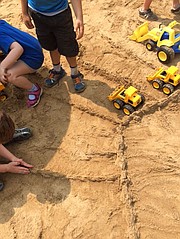While summer is opportunity for fun, it can also be a breeding ground for stagnation. In fact, the National Summer Learning Association reports children can experience learning loss when they are not engaged in educational activities while on school break. From summer reading programs at local libraries to nature walks in the woods, local educators offer ideas for combining enriching experiences and warm weather fun.
“Most local libraries have a reading program that offers kids incentives for reading books during the summer,” said Peggy Woodstock, a Bethesda, Md., based reading specialist. “They add an element of competition which can offer a boost to many kids.”
Think of the natural world as an interactive classroom as well. “Hiking and camping are great ways to get kids excited about science and nature,” said Amy Adams, director, Aspiring Scientists Summer Internship Program at George Mason University in Fairfax. “There are some local parks that have nature programs and guided walks.”
Adams recommends Eleanor Lawrence Park in Chantilly and Great Falls Park in McLean. “Allow children to explore, but it’s always nice to give guidance as well,” said Adams. “For example, ‘Let’s go on this hike and look for evidence that an animal was present,’ and then kids get involved trying determine which animal it was.’”
Trading video games for blue foam blocks at the National Building Museum’s “Work, Play, Build” exhibit is another option. It’s a hands-on, interactive space that offers children an opportunity to see the work of architects and engineers.
The National Zoo and the Natural History Museum in Washington, D.C., the National Aquarium in Baltimore, Maryland and the Air and Space Museum’s Steven F. Udvar-Hazy Center in Chantilly are also good choices for children. In addition, the Potomac Overlook Nature Center in Arlington is “great for teaching kids about birds, turtles and birds of prey,” said Adams. “Farms or petting zoos are also great for teaching kids about animals and nature.
“4-H programs at local fairs would be another great way to learn about nature and animals,” Adams continued. “Parents can look online for at-home science experiments for kids,” on sites like http://www.curiosityzone.com/Experiments.
There is plenty of inspiration to be had at home as well, says Gail Multop, who teaches early childhood development at Northern Virginia Community College. “You can build things at home with your kids,” she said. “Experiments with water are great. Use funnels and buckets of water and experiment with how water flows.” Multop shares ideas for learning on her blog, “The Arts and Early Childhood Education.”
For building projects at home, “parents should save cardboard, paper towel rolls, shoeboxes, etc. and provide duct tape and paints. Kids can build castles [and] space ships,” she added.
For more inspiration, Multop recommends a blog by Alexandria-based educator Peggy Ashbrook: http://families.naeyc.org/blog/124.
“She has lots of activities on it that encourage learning about science in a fun way,” said Multop. “What’s really important for kids is to inquire and for parents not to give them the answer, but help them find the answers.”
